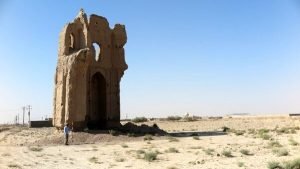
TEHRAN – A team of Iranian archaeologists has discovered over 50 historical sites and relics during its thorough expedition on the eastern basin and lands of the Zayandeh River.
“The relics and ruined sites date from the Bronze Age, Sassanid era, and early Islamic times were discovered during the field research conducted from Gavkhouni wetland to the southern plains of Varzaneh-Kafroud,” ILNA on Saturday quoted Yaser Jebraeili who presides over the archaeological expedition.
The survey was aimed to identify potential archeological sites, develop knowledge over cultural landscapes and their changes over time, and determine patterns of settlements in the cited area that covers some 200 square kilometers, the archaeologist explained.
Isfahan has long been nicknamed as Nesf-e-Jahan which is translated into “half of the world”, suggesting that seeing it is equivalent to seeing half of the world. The history of Isfahan can be traced back to at least the Achaemenid era (559–330 BC), but little is known about the area before the rule of the Sassanid dynasty (c. 224 – c. 651 CE).
The Shahrestan Bridge, which spans the Zayandeh River a short distance southeast of the city, dates from the Sasanian era; the piers are, however, all that remains of the original structure, the upper part having often been rebuilt. After the Arab conquest in 642, the city came to be known by the regional name Isfahan. Under the Arabs, it served as the capital of Al-Jibal (“the Mountains”) province, an area that covered much of ancient Media.
Isfahan grew prosperous under the Persian Buyid (Buwayhid) dynasty, which rose to power and ruled much of Iran when the temporal authority of the ʿAbbasid caliphs waned in the 10th century.
Toghril Beg, the Turkish conqueror and founder of the Seljuq dynasty, made Isfahan the capital of his domains in the mid-11th century, and under his famous grandson Malik-Shah I (reigned 1073–92) the city grew in size and splendor.
After the fall of the Seljuks (c. 1200), Isfahan temporarily declined and was eclipsed by other Iranian cities such as Tabriz and Qazvin, but it regained its preeminent position during the Safavid period (1501–1736). The city’s golden age began in 1598 when the Safavid ruler ʿAbbas I (the Great; reigned 1588–1629) made it his capital and rebuilt it into one of the largest and most beautiful cities of the 17th century.
According to Britannica, a French Huguenot jeweler and writer, Jean Chardin, spent 10 years in Isfahan between 1664 and 1677 and in his Voyages gave a detailed and graphic description of the city as it was at its zenith. It then had, he said, 162 mosques, 273 public baths, 1,802 caravansaries, and 48 madrasahs (religious colleges).
Isfahan was a crossroads of international trade and diplomacy during the 16th and 17th centuries, and now it is one of Iran’s top tourist destinations for good reasons. It is a city for walking, getting lost in its mazing bazaars, dozing in beautiful gardens, and meeting people.
